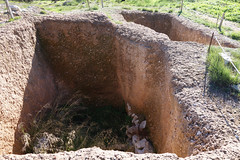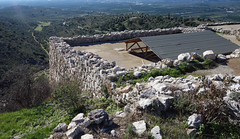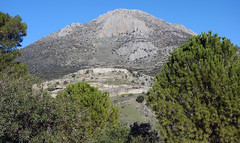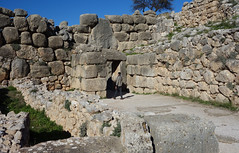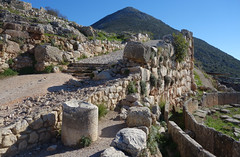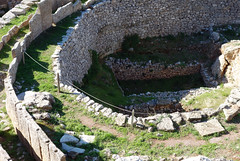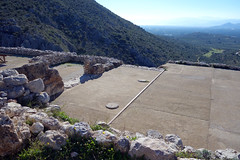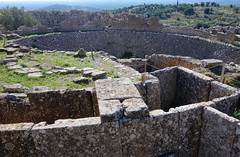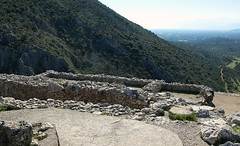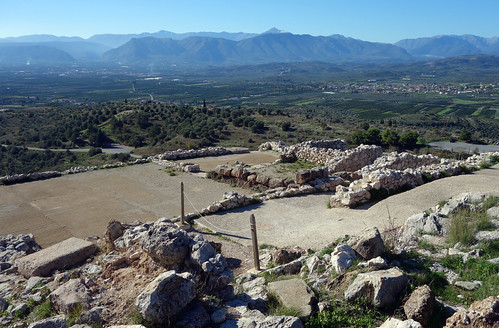2.4: Ancient Aegean
- Page ID
- 63637
\( \newcommand{\vecs}[1]{\overset { \scriptstyle \rightharpoonup} {\mathbf{#1}} } \)
\( \newcommand{\vecd}[1]{\overset{-\!-\!\rightharpoonup}{\vphantom{a}\smash {#1}}} \)
\( \newcommand{\dsum}{\displaystyle\sum\limits} \)
\( \newcommand{\dint}{\displaystyle\int\limits} \)
\( \newcommand{\dlim}{\displaystyle\lim\limits} \)
\( \newcommand{\id}{\mathrm{id}}\) \( \newcommand{\Span}{\mathrm{span}}\)
( \newcommand{\kernel}{\mathrm{null}\,}\) \( \newcommand{\range}{\mathrm{range}\,}\)
\( \newcommand{\RealPart}{\mathrm{Re}}\) \( \newcommand{\ImaginaryPart}{\mathrm{Im}}\)
\( \newcommand{\Argument}{\mathrm{Arg}}\) \( \newcommand{\norm}[1]{\| #1 \|}\)
\( \newcommand{\inner}[2]{\langle #1, #2 \rangle}\)
\( \newcommand{\Span}{\mathrm{span}}\)
\( \newcommand{\id}{\mathrm{id}}\)
\( \newcommand{\Span}{\mathrm{span}}\)
\( \newcommand{\kernel}{\mathrm{null}\,}\)
\( \newcommand{\range}{\mathrm{range}\,}\)
\( \newcommand{\RealPart}{\mathrm{Re}}\)
\( \newcommand{\ImaginaryPart}{\mathrm{Im}}\)
\( \newcommand{\Argument}{\mathrm{Arg}}\)
\( \newcommand{\norm}[1]{\| #1 \|}\)
\( \newcommand{\inner}[2]{\langle #1, #2 \rangle}\)
\( \newcommand{\Span}{\mathrm{span}}\) \( \newcommand{\AA}{\unicode[.8,0]{x212B}}\)
\( \newcommand{\vectorA}[1]{\vec{#1}} % arrow\)
\( \newcommand{\vectorAt}[1]{\vec{\text{#1}}} % arrow\)
\( \newcommand{\vectorB}[1]{\overset { \scriptstyle \rightharpoonup} {\mathbf{#1}} } \)
\( \newcommand{\vectorC}[1]{\textbf{#1}} \)
\( \newcommand{\vectorD}[1]{\overrightarrow{#1}} \)
\( \newcommand{\vectorDt}[1]{\overrightarrow{\text{#1}}} \)
\( \newcommand{\vectE}[1]{\overset{-\!-\!\rightharpoonup}{\vphantom{a}\smash{\mathbf {#1}}}} \)
\( \newcommand{\vecs}[1]{\overset { \scriptstyle \rightharpoonup} {\mathbf{#1}} } \)
\( \newcommand{\vecd}[1]{\overset{-\!-\!\rightharpoonup}{\vphantom{a}\smash {#1}}} \)
\(\newcommand{\avec}{\mathbf a}\) \(\newcommand{\bvec}{\mathbf b}\) \(\newcommand{\cvec}{\mathbf c}\) \(\newcommand{\dvec}{\mathbf d}\) \(\newcommand{\dtil}{\widetilde{\mathbf d}}\) \(\newcommand{\evec}{\mathbf e}\) \(\newcommand{\fvec}{\mathbf f}\) \(\newcommand{\nvec}{\mathbf n}\) \(\newcommand{\pvec}{\mathbf p}\) \(\newcommand{\qvec}{\mathbf q}\) \(\newcommand{\svec}{\mathbf s}\) \(\newcommand{\tvec}{\mathbf t}\) \(\newcommand{\uvec}{\mathbf u}\) \(\newcommand{\vvec}{\mathbf v}\) \(\newcommand{\wvec}{\mathbf w}\) \(\newcommand{\xvec}{\mathbf x}\) \(\newcommand{\yvec}{\mathbf y}\) \(\newcommand{\zvec}{\mathbf z}\) \(\newcommand{\rvec}{\mathbf r}\) \(\newcommand{\mvec}{\mathbf m}\) \(\newcommand{\zerovec}{\mathbf 0}\) \(\newcommand{\onevec}{\mathbf 1}\) \(\newcommand{\real}{\mathbb R}\) \(\newcommand{\twovec}[2]{\left[\begin{array}{r}#1 \\ #2 \end{array}\right]}\) \(\newcommand{\ctwovec}[2]{\left[\begin{array}{c}#1 \\ #2 \end{array}\right]}\) \(\newcommand{\threevec}[3]{\left[\begin{array}{r}#1 \\ #2 \\ #3 \end{array}\right]}\) \(\newcommand{\cthreevec}[3]{\left[\begin{array}{c}#1 \\ #2 \\ #3 \end{array}\right]}\) \(\newcommand{\fourvec}[4]{\left[\begin{array}{r}#1 \\ #2 \\ #3 \\ #4 \end{array}\right]}\) \(\newcommand{\cfourvec}[4]{\left[\begin{array}{c}#1 \\ #2 \\ #3 \\ #4 \end{array}\right]}\) \(\newcommand{\fivevec}[5]{\left[\begin{array}{r}#1 \\ #2 \\ #3 \\ #4 \\ #5 \\ \end{array}\right]}\) \(\newcommand{\cfivevec}[5]{\left[\begin{array}{c}#1 \\ #2 \\ #3 \\ #4 \\ #5 \\ \end{array}\right]}\) \(\newcommand{\mattwo}[4]{\left[\begin{array}{rr}#1 \amp #2 \\ #3 \amp #4 \\ \end{array}\right]}\) \(\newcommand{\laspan}[1]{\text{Span}\{#1\}}\) \(\newcommand{\bcal}{\cal B}\) \(\newcommand{\ccal}{\cal C}\) \(\newcommand{\scal}{\cal S}\) \(\newcommand{\wcal}{\cal W}\) \(\newcommand{\ecal}{\cal E}\) \(\newcommand{\coords}[2]{\left\{#1\right\}_{#2}}\) \(\newcommand{\gray}[1]{\color{gray}{#1}}\) \(\newcommand{\lgray}[1]{\color{lightgray}{#1}}\) \(\newcommand{\rank}{\operatorname{rank}}\) \(\newcommand{\row}{\text{Row}}\) \(\newcommand{\col}{\text{Col}}\) \(\renewcommand{\row}{\text{Row}}\) \(\newcommand{\nul}{\text{Nul}}\) \(\newcommand{\var}{\text{Var}}\) \(\newcommand{\corr}{\text{corr}}\) \(\newcommand{\len}[1]{\left|#1\right|}\) \(\newcommand{\bbar}{\overline{\bvec}}\) \(\newcommand{\bhat}{\widehat{\bvec}}\) \(\newcommand{\bperp}{\bvec^\perp}\) \(\newcommand{\xhat}{\widehat{\xvec}}\) \(\newcommand{\vhat}{\widehat{\vvec}}\) \(\newcommand{\uhat}{\widehat{\uvec}}\) \(\newcommand{\what}{\widehat{\wvec}}\) \(\newcommand{\Sighat}{\widehat{\Sigma}}\) \(\newcommand{\lt}{<}\) \(\newcommand{\gt}{>}\) \(\newcommand{\amp}{&}\) \(\definecolor{fillinmathshade}{gray}{0.9}\)Ancient Aegean
The art of the Cycladic islands, the Minoans (on Crete), and the Mycenaeans (on the Greek mainland).
3200 - 1050 B.C.E.
Cycladic
The Cyclades is a group of about thirty small islands in the Aegean Sea.
3200 - 1050 B.C.E.
Male Harp Player from Keros
by DR. BETH HARRIS and DR. STEVEN ZUCKER
Modern artists fell in the love with these abstract 5000 year old sculptures—but what was their real meaning?
Smarthistory images for teaching and learning:
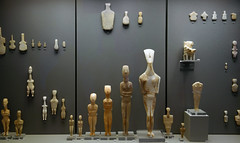
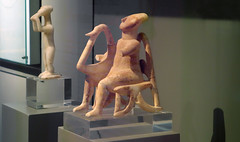
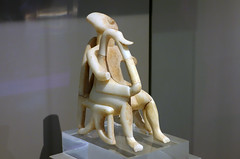
Akrotiri, Thera
by STEVEN ZUCKER and BETH HARRIS
Hidden under volcanic ash for millennia, the beautiful frescoes in the houses of Akrotiri were recently unearthed.
Video \(\PageIndex{2}\): Frescoes from Akrotiri, on the Cycladic island Thera (Santorini), Greece, 16th century B.C.E., Aegean Bronze Age (National Archaeological Museum, Athens)
Smarthistory images for teaching and learning:
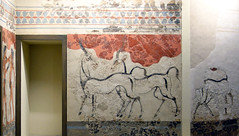
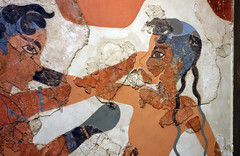
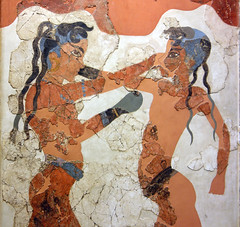
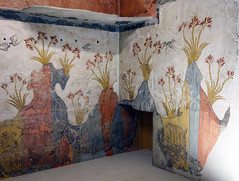
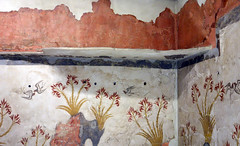

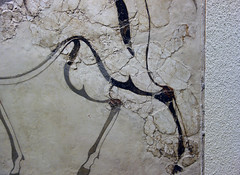

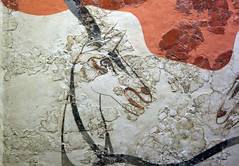
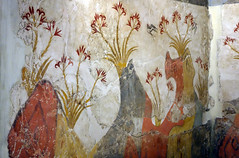

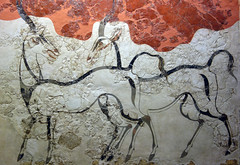

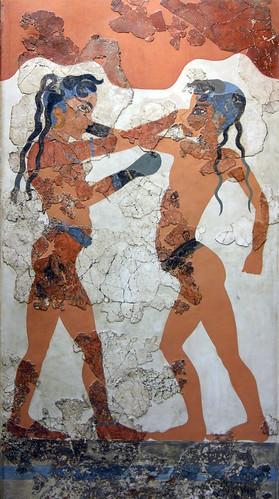
Minoan
Minoan culture is characterized by the building of remarkable palaces (really administrative centers) decorated with colorful frescoes.
c. 3000 – c. 1100 B.C.E.
Minoan art
The remarkable and influential bronze-age culture on the island of Crete is called "Minoan" after the mythic King Minos.
The Palace at Knossos (Crete)
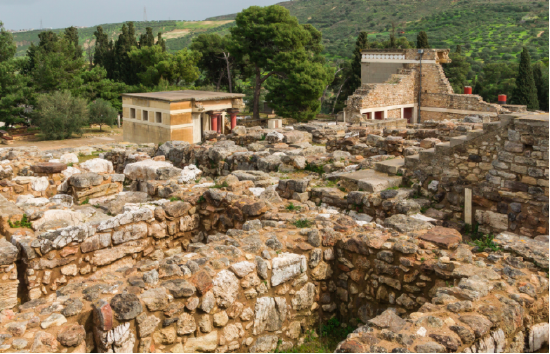
Restoration versus conservation
What happens to an archaeological site after the archaeologist’s work is completed? Should the site (or parts of it) be restored to what we believe (based on evidence) it once looked like? Or should the site be protected through conservation and left as is? A visit to an unrestored archaeological site can be uninspiring—even the most lavish ancient sites can appear to be piles of unorganized stones framed by broken columns and other fragments. And while modern conservation principles insist on the reversibility of any treatment (in case better treatments are discovered in the future), in the past, conservators didn’t have the resources or science that is available today.
Knossos
The archaeological site of Knossos (on the island of Crete) —traditionally called a palace—is the second most popular tourist attraction in all of Greece (after the Acropolis in Athens), hosting hundreds of thousands of tourists a year. But its primary attraction is not so much the authentic Bronze Age remains (which are more than three thousand years old) but rather the extensive early 20th century restorations installed by the site’s excavator, Sir Arthur Evans, in the early twentieth century.
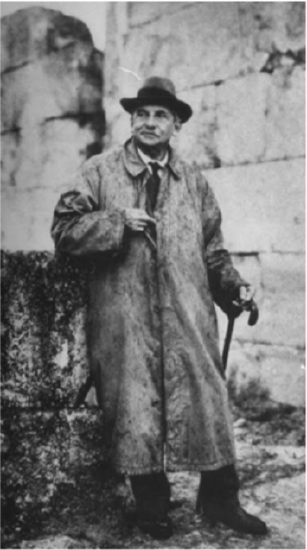
Archaeological restorations offer important information about the history of a site and Knossos doesn’t disappoint—one can see the earliest throne room in Europe, walk through the monumental Northern entrance to the palace, marvel at colorful wall paintings and enjoy the elegance of a queen’s apartments. All these spaces, however, are the result of extensive, contentious and, in some cases, damaging restoration. Knossos asks us to consider how we can preserve an archaeological site, while at the same time providing a valuable, educational experience for visitors that nonetheless remains true to the remains.
Considering Evans’ reconstructions
The Evans restoration at Knossos are important for several reasons:
- If Evans hadn’t worked to preserve and restore so much of Knossos beginning in 1901, it would have undoubtedly been largely lost.
- The restoration of the site undertaken by Evans, with its elegantly painted Throne Room (below) makes very real our historical understanding, originally revealed by Homer, of the power and prestige of the kings of Crete.
- The beautiful, although sometimes inaccurate, restorations of architecture and wall paintings by Evans evoke the elegance and skill of Minoan architects and painters.
These are the undeniable benefits of Evans’s restorations and among the aspects of a visit to Knossos that everyone values. It is the smooth corniced walls, bright paintings, and whole passages stepped with balustrades at Knossos that the post cards, camera snaps, and human memory preserve, and that has translated into important support for the site—intellectually, politically, and financially.

At the same time, the Evans restorations are problematic. In some cases, what is restored does not accurately reflect what was found. Instead, a grander, and more complete, experience is presented. For example, when you visit Knossos, because of the way it is reconstructed, it is very easy to believe that all that was ever found there was a Late Bronze Age palace.
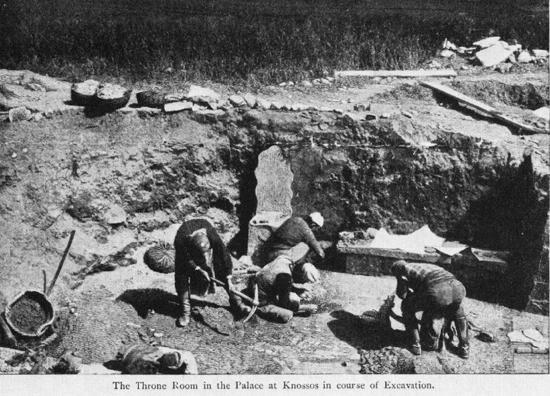
Evans’s restoration of the Throne Room (and much else at the site) privileges the Late Bronze Age period of its history. The typical visitor likely won’t grasp that the Throne Room dates to the latest phase of Knossos—the end of the 2nd millennium B.C.E., though the site was occupied nearly continuously from the Neolithic to the Roman era (from the 8th millennium B.C.E. to at least the 5th century C.E.).
The power of Evans’s interpretation and reconstruction of the site as purely Minoan—the product of the indigenous culture of that island—is very much still with us despite the fact that much has changed about how art historians and archaeologists understand the different periods of construction at Knossos. Today, much of its final plan and form, which Evans reconstructed (including the Throne Room and most of the frescos), are understood as being of Mycenaean construction (not Minoan). Although this information is noted in texts mounted at the site, it is too often overlooked by visitors.
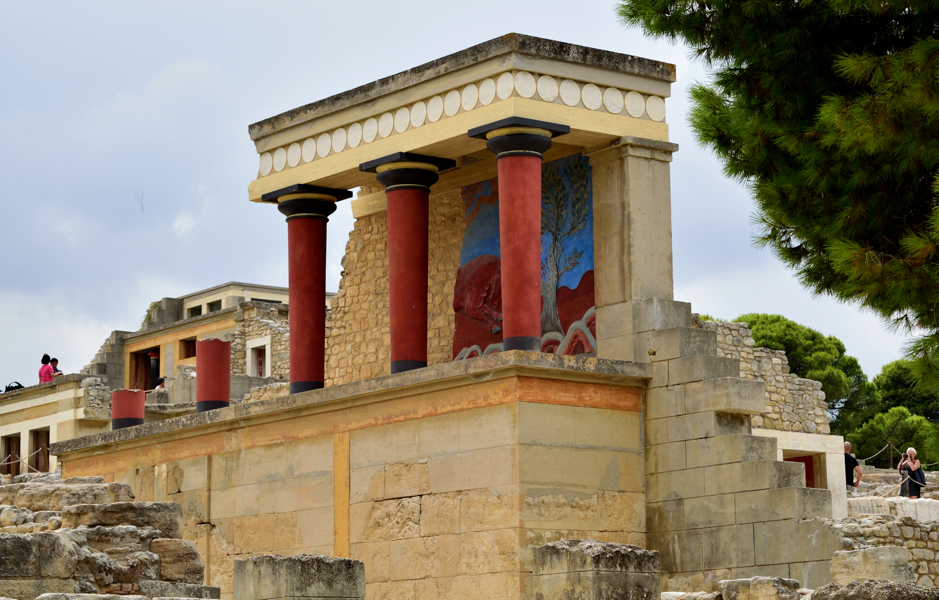
What is archaeological restoration?
When archaeological remains are revealed through excavation, they are often delicate and cannot survive long unprotected. Some archaeologists backfill their trenches (refill the excavated holes with the material that was removed) to help preserve remains. In other instances, architecture, graves, or the impressions left from ephemeral building materials (such as wood) are sometimes left exposed, and when this happens some sort of conservation should occur. By definition, any sort of conservation is restoration when the modern materials are layered on the ancient and made to look harmonious in form, color and/or texture. As a result, restorations are sometimes nearly indistinguishable from authentic materials, and this is where things get tricky—such as the situation at Knossos.
Before making an archaeological restoration, three essential issues must be examined:
- What specific point in a site or monument’s history will be the subject of the restoration? Many (most!) archaeological sites reflect a long occupation or use, and within that timeframe things change, are repaired, or rebuilt. What era of the site will be privileged by the restoration—and in turn, which eras of the site’s history will become harder to see and understand?
- How will future changes in the interpretation and knowledge about a site or monument be accommodated by restorations? Archaeological interpretations of sites evolve all the time, often through new discoveries elsewhere. Restorations, in order to remain accurate, need to take into account potential new scholarship that can change the history or meaning of a site or monument.
- Lastly and most importantly, restorations must be non-destructive and reversible. The first role of restoration is conservation. Therefore, the original remains must be entirely safe and not harmed in any way by restoration methods and materials. The reversibility of restorations not only has to do with the accommodation of changes in interpretation made above, but also with the need to leave the way open for less invasive, more gentle restoration methods in the future.
Restoration at Knossos
Aside from some gaps (for instance, during the First World War) Evans excavated at the site of Knossos each year from 1900 to 1930. Restoration of the architectural finds began almost immediately and can be divided into three phases, each characterized by the architect Evans hired to do the work. These three men, Theodore Fyfe, Christian Doll, and Piet De Jong, each had very different restoration philosophies.
Phase 1: Theodore Fyfe
From 1901 to 1904, a young architect by the name of Theodore Fyfe was charged with the restorations at Knossos. It is likely that Evans hired him because the winter of 1900/01 had damaged the newly exposed Throne Room—the most important space excavated during that first season at the site.
Fyfe’s work at Knossos can be characterized by two things. First of all, he was devoted to the concept of minimal intervention. Second, when intervention was necessary, he made great efforts to use materials authentic to the Bronze Age structure (wood, limestone, rubble masonry) and even to use Bronze Age construction techniques, which he was able to glean from his onsite work. Clearly Fyfe was highly concerned about the truthfulness of his interventions and reconstructions; the only exception to this was his construction of modern-style pitched roofs to protect the Throne Room and the Shrine of the Double Axes.
Phase 2: Christian Doll
The second phase of restoration work at Knossos dates from 1905 to 1910, and was directed by Christian Doll. The first conservation work to which Doll had to attend to in 1905 was that of Fyfe’s. Essentially, Fyfe’s zeal to use authentic materials resulted in failure: he neglected in many cases to treat timbers before their use and he tended to use softwoods rather than hardwoods (all of which lead to rot). Also, rain was a destructive force in the winters, especially when it ran through newly exposed parts of the site. Doll’s first and most important project was to stabilize and reconstruct the Grand Staircase to its original four story height. This was an extremely difficult job as the exact nature of the ancient design eluded both him and Fyfe, so a certain amount of improvisation was needed. And, because the weight of the structure was so great, Doll used iron girders (imported from England at great expense) covered in cement to make them look like ancient wooden beams.
Doll’s approach to conservation was still anchored in preserving the excavated remains. However, Doll was no fan of the authentic materials used by Fyfe, as he saw how they had failed to preserve the many areas where they had been employed. Instead, Doll constructed structural systems based on techniques used in London at the time. Moreover, he employed contemporary architectural materials, such as the iron girders mentioned above, as well as concrete (the first use of this material at Knossos).
Phase 3: Piet De Jong

The third phase of conservation work was executed over a longer period of time, from 1922 to 1952, by Piet De Jong. The vast majority of what Knossos looks like today, with large passages of reconstructed walls and rooms, is his work.
Three main elements characterize De Jong’s work at Knossos. The most prominent was his use of iron reinforced concrete. In the twelve years between Doll’s and De Jong’s work, the use of reinforced concrete had grown in popularity because of its speedy construction, its relative cheapness, and its ability to be molded into nearly any shape. It was also thought to be nearly indestructible.
Another essential characteristic of De Jong’s work at Knossos was his use of reinforced concrete to construct parts of the palace beyond what had been found—some passages were based on archaeological evidence, some were not (the bases of these reconstructions came from Evans himself).
De Jong often did not merely end walls at the height of their discovery but would either finish them off with a flat roof and cornice, often decorated with double white horns (what some contemporary wall paintings of Bronze Age houses looked like), or would leave the top edge of walls with irregular stones, evoking a picturesque, antique view. When a complete vision of ancient Knossos could not be reconstituted, a romantic one was built instead.
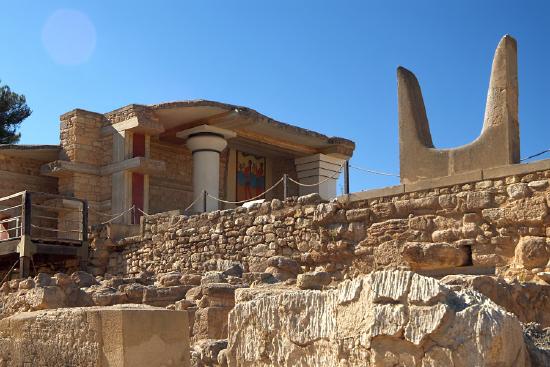
The reconstruction of the interior decoration of the throne room was executed during this period and similarly exhibits a combination of the truthful reflection of archaeological remains and Evans’s creativity.
Lastly, an important characteristic of De Jong’s restorations was the placement of reproductions of wall paintings around his newly built spaces. Some paintings were placed very close to their findspots and therefore aimed at a more authentic reconstruction, while other paintings were reconstructed at some distance from where they had been discovered.
The question remains: why did Evans encourage De Jong’s radical approach to conservation, especially after two more conservative predecessors? Several reasons are at play, no doubt. The first, and possibly the most important, is the condition of Knossos after almost eight years of abandonment during the First World War. Aside from the wild overgrowth of weeds, there was much weather-related and other damage. However, the parts of the site that had been roofed (such as the Throne Room and the Shrine of the Double Axes) and sections that were more intact (such as the Grand Staircase), were in excellent shape and this no doubt convinced Evans of the importance of aggressive conservation work. Second, the iron-reinforced concrete which De Jong proposed to use was inexpensive and could be employed quickly. Third, Evans, in a masterful anticipation of the desires of future tourism, aimed to make a site that would vividly conjure the culture he had discovered, as much evocative and picturesque as historically accurate.
Conservation at Knossos after Evans
It is only fair to reflect upon the restorations of Knossos within their historical framework. The aims, methods, and materials used in restoration at the site over a period of some sixty years changed, reflecting a long list of crises, constraints, theories, and desires. Perhaps most significant, however, was Evans’s overriding conviction that the conservation of Knossos was an obligation born out of its great antiquity and unique importance. He knew this from his own Edwardian education, British colonial outlook, and his twenty-four year directorship of the Ashmolean Museum at the University of Oxford. Evans was keenly aware of how intimately connected the teaching of Knossos’s history was with how it was presented on site. He made Knossos into a museum and a showcase for the newly discovered Aegean Bronze Age chapter of ancient history and the earliest example of cultural tourism, today a mainstay of public historical education—not to mention local economies. Evans did it first at Knossos.
Conservation at Knossos has continued since De Jong’s work, although with new challenges. The most recent conservation work on the site has been focused largely on repairing Evans’s reconstructions. Despite a belief that reinforced concrete would last indefinitely, it has proven to be susceptible to the wet Cretan winters, crumbling and allowing for rust on the interior ironwork. In other areas the reinforced concrete proved to be structurally unsound.
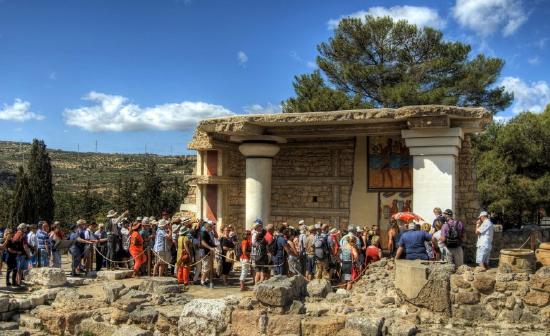
In addition, the steady increase of tourist traffic since the 1950s has meant growing stress on both the original architecture of Knossos as well as its reconstructions. Sustained foot fall, increasing weight load as well as touching and sitting, is increasingly destructive. To combat this, the Greek Archaeological Service, under the Greek Ministry of Culture and Sports, has closed off large sections of Knossos and generally restricted circulation on the site. In the 1990s it conducted extensive conservation of both ancient and modern structures as well as building new corrugated plastic roofing. At present the Service is working on a visitor management plan for the site and the Greek government has applied to UNESCO for World Heritage Status for Knossos as well as four other Minoan palatial sites which would afford much needed support for ongoing conservation efforts.
In addition, the steady increase of tourist traffic since the 1950s has meant growing stress on both the original architecture of Knossos as well as its reconstructions. Sustained foot fall, increasing weight load as well as touching and sitting, is increasingly destructive. To combat this, the Greek Archaeological Service, under the Greek Ministry of Culture and Sports, has closed off large sections of Knossos and generally restricted circulation on the site. In the 1990s it conducted extensive conservation of both ancient and modern structures as well as building new corrugated plastic roofing. At present the Service is working on a visitor management plan for the site and the Greek government has applied to UNESCO for World Heritage Status for Knossos as well as four other Minoan palatial sites which would afford much needed support for ongoing conservation efforts.
Kamares Ware Jug
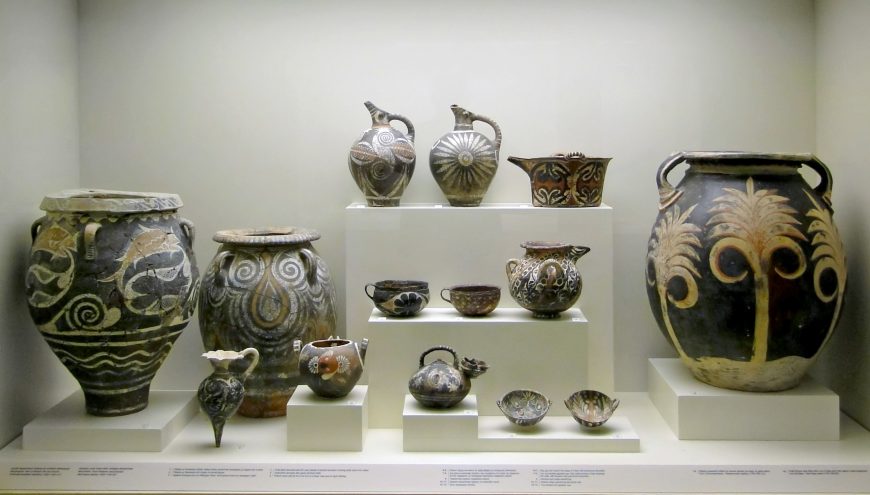
Look closely at the jug on the top shelf at the far left in the photograph above. Can you almost see a bird looking up to the sky?
The pottery we see in this photograph is called Kamares Ware, and it was the first fine, mass-produced and widely-traded pottery produced on Minoan Crete, dating to the Middle Minoan era (1900-1700 B.C.E.). It was Sir Arthur Evans, the archaeologist who first uncovered the Minoan palace at Knossos, who divided Minoan chronology into different periods and it was Evans who was also responsible for using the name “Minoan” to refer to the Bronze Age culture of Crete (after the legendary King Minos). Minoan culture flourished between c. 2600 and c. 1600 B.C.E. The Kamares cave, discovered in 1864, is the location of a Minoan archaeological site on Crete, and some of the best examples of Middle Minoan pottery have been found there—hence the name Kamares ware.
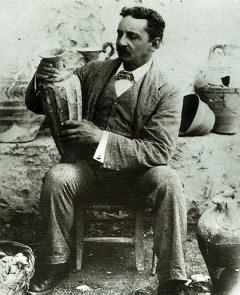
Kamares ware is characterized by light-on-dark abstract and floral patterns and elegant shapes. The crafting of these shapes was executed on a fast-spinning potter’s wheel, a new invention during the Middle Minoan era, and its painted decoration is particularly labor intensive, requiring a dark background color, usually black, on which white and sometimes red and orange colors were added. This was a departure from earlier Early Minoan pottery which merely added dark abstract designs to the buff background color of the clay. Perhaps the most remarkable type of Kamares ware is referred to as eggshell ware, named for the extreme thinness of the vessel walls. The overall effect of Kamares ware is not just a pretty pot but an object which is a wonder to behold—at once inventive, delicate, and full of movement and charm.


This Kamares ware jug is a classic example of the type. It was found at the Minoan palace of Phaistos, which is in south central Crete. Phaistos and its sister palace Knossos to the north were the two main manufacturing centers for Kamares-ware pottery in the middle Bronze Age.
The vessel is painted with a black background and most of the abstract decoration is painted in either white or red. The belly of the jug, its broadest circumference, is where the main action of the design takes place: two abstract shapes, an “S” shaped double spiral and a striped oval shape alternate like beads on a string. Each is connected to the other by a white line which seems to expand and contract with the pull of the double spiral. The oval shapes are grounded in the composition with white triangles, under which is a succession of smaller triangles angled to the left. A red stripe separates the neck of the jug from its body and the spout and handle are striped.
At first glance, the shape of the jug is simple but when you begin to understand the painting, you realize that it is a zoomorphic shape, meant to imitate an animal, in this case, a bird with its beak in the air and a striped plume emerging from the top of its head (the handle). With this, the jug has a dual reading: it can be seen as a bulbous sphere with alternating swirling spheres, or a proud bird, looking up to the sky and contemplating flight.
Probably the most important thing about Kamares ware is how it helps us map the trading relationships of the Minoans with the Mediterranean at large. Kamares ware pottery has been found in Egypt, the Levant, the Cycladic islands, mainland Greece, and southern Italy. In this, it is the first true marker of Bronze Age Crete’s economic reach.
Snake Goddess

An enticing mystery
It has been said that the image of the Snake Goddess, discovered by Sir Arthur Evans at Knossos on Crete, is one of the most frequently reproduced sculptures from antiquity. Whether or not this is true, it is certainly the case that she is a powerful and evocative image. What she meant to the Minoans who made her, however, is not very well understood.
The “Temple Repositories”
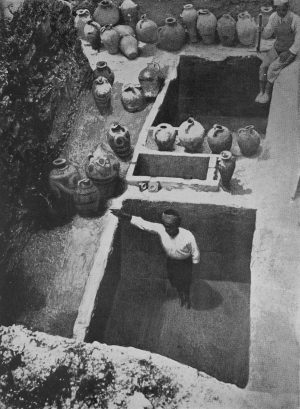
Evans found the sculpture of the Snake Goddess in a secondary exploration of the complex he called a “palace” at Knossos. After digging out the entire western wing, he decided to check under the paving stones. Most covered nothing but earth, but just south of the Throne Room, he discovered two stone-lined pits containing a wide variety of precious things, mostly broken: scraps of gold, ivory, faience (the largest deposit of faience on Crete), stone inlay, unworked horn, ceramic vessels, seal stones, sealings, shells, the vertebrae of large fish, and the broken pieces of at least three figurines, of which the Snake Goddess was one.
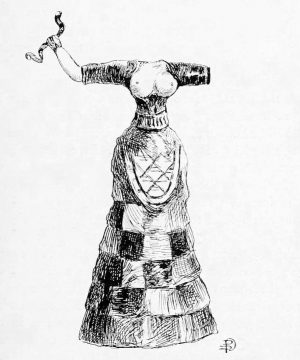
Because of the fragmentary nature of these valuable objects, Evans assumed what he had found were damaged pieces that had been cleaned out from a temple. He named the pits the “Temple Repositories” and immediately set upon the reconstruction of as much as he could, with special interest in the figurines, which he assumed were of goddesses.
The hat and the cat
The Snake Goddess, as originally excavated, lacked a head and half of her left arm. The complete right arm held a short wavy striped stick, which Evans interpreted as a snake. This was, in some measure, to match the other nearly complete figurine found in the Temple Repositories, which clearly had snakes slithering up both of her arms. The restoration of the Snake Goddess was done by the Danish artist Halvor Bagge together with Evans. Their contribution to the figurine was the creation of a matching arm and stripy snake, the head of the goddess, and the placement of the hat and cat (separate faience pieces found in the Temple Repositories) on her head.
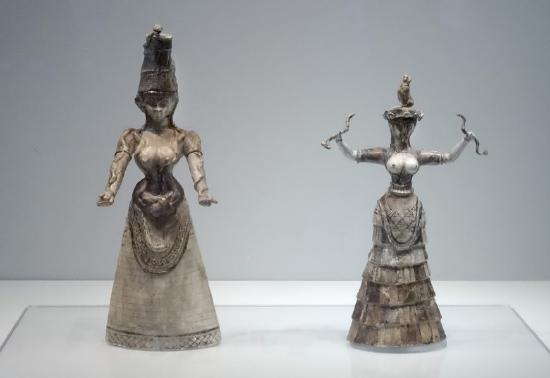
In her restored state, the Snake Goddess is 29.5 cm (about 11.5 inches) high, a youthful woman wearing a full skirt made of seven flounced layers of multicolored cloth. This is likely not a representation of striped cloth, but rather flounces made from multiple colorful bands of cloth, the weaving of which was a Minoan specialty. Over the skirt she wears a front and back apron decorated with a geometric diamond design. The top of the skirt and apron has a wide, vertically-striped band that wraps tightly around the figure’s waist. On top, she wears a short-sleeved, striped shirt tied with an elaborate knot at the waist, with a low-cut front that exposes her large, bare breasts. The Snake Goddess’s head, restored by Bagge and Evans, stares straight forward, topped by the spherical object that Bagge and Evans believed would make a good crown, and, finally, a small sitting cat. Her long black hair hangs down her back and curls down around her breasts.
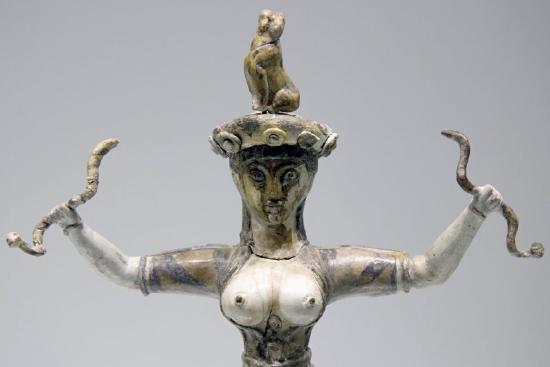
Really a goddess?
The Snake Goddess is a provocative image, but its restoration and interpretation are problematic. The crown and cat have no parallel in any image of a Bronze Age woman, so these should be discounted. The interpretation of this figure as a goddess is also difficult, since there is no evidence of what a Minoan goddess might have looked like. Many images of elite Minoan women, perhaps priestesses, look very much like this figurine. If it is the action of snake-wrangling that makes her a goddess, this is also a problem. The image of a woman taming one or more snakes is entirely unique to the Temple Repositories. Therefore, If she is a snake goddess, she is not a particularly popular one.
Certainly, Evans was interested in finding a goddess at Knossos. Even before he excavated at the site, he had argued that there was a great mother goddess who was worshiped in the pre-Classical Greek world. With the Snake Goddess, Evans found—or fashioned—what he had anticipated. Its authenticity and meaning, however, leave many questions today.
Additional resources:
Bull’s Head Rhyton

Ritual vessels
Images of bulls are among the most important in Minoan art and as many as eleven bull’s head rhyta come from the site of Knossos.
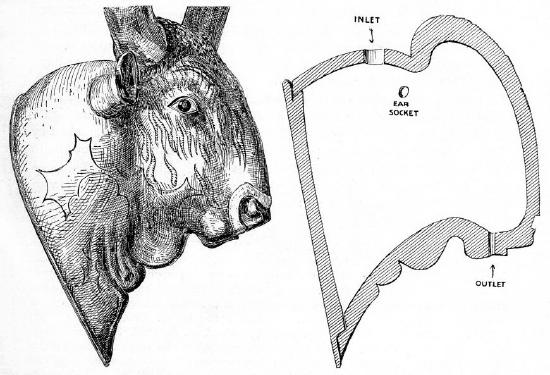
A rhyton is a ritual vessel used for pouring liquids, with a hole at the top and the bottom. This rhyton was found in a structure called the Little Palace (it is called a “palace” because of its size and elite architectural elements, not because there was a throne in it), about 200 meters northwest of the palace at Knossos. The rhyton dates to the original Neopalatial period (1600-1450 B.C.E.), when the building was constructed, and was likely purposefully broken before it was discarded. It is heavily damaged—the left side of the bull’s head and left ear, as well as its golden horns, were restored by Sir Arthur Evans.
This bull’s head rhyton was carved from a single block of black steatite and is 26 cm (about 10 inches) in height, as restored. It is hollow, as a rhyton must be, with the hole at the top behind the bull’s horns and the hole at the bottom at its muzzle. The back of the rhyton is flat so that it could be laid down on a surface.

Both realistic and stylized
The carving of the bull’s head is remarkable for its combination of vivid realism and stylization. For instance, the eyes of the bull were made of inlaid rock crystal lenses, painted on their flat back with a black iris and red pupil, surrounded in white. The rim of the eye was inlaid with red jasper, giving the bull a wild, frightening, bloodshot look.
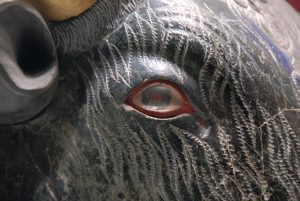
The bull is shaggy, with naturalistic locks hanging down its face, carved with very shallow incisions in the soft stone and filled with ground white stone (perhaps gypsum) for contrast against the black steatite. Also very realistically carved are the rolls of skin at the neck of the bull. However, other parts of the representation of the bull are rather stylized. For instance, the hair whorl at the center of the bull’s forehead looks more like a spiral than a swirled tuft of hair, and this is topped by a patch of stylized fur with curls arranged in rows. Lastly, the patch of white hair around the snout of the bull, rendered with shell inlay, looks graphic in its straight borders.
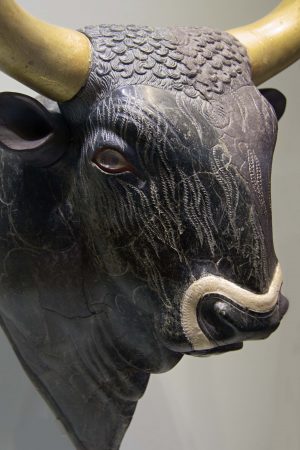
Treasured gifts
Bull’s head rhyta such as this one were some of the most valued treasures of Minoan Crete. Images of them appear in 18th dynasty Egyptian wall paintings, where they are shown as pharaonic gifts from visiting Cretans. Many examples of rhyta have been archaeologically recovered; some twenty-three of them have been found at archaeological sites on Crete and the Greek mainland. What is remarkable is that all have been found purposefully destroyed. This has led archaeologists to believe that after the utility of a bull’s head rhyton had expired, it was ritually destroyed.
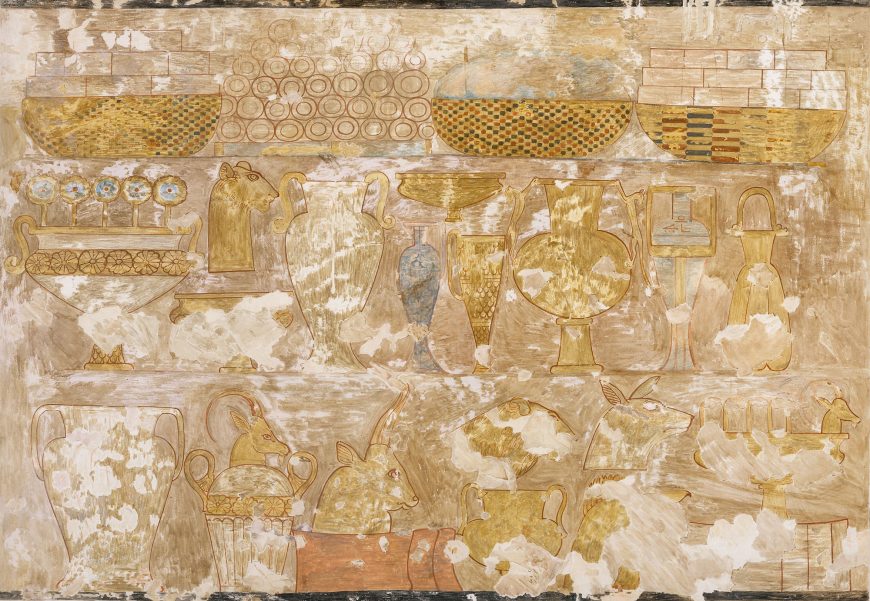
Harvester Vase
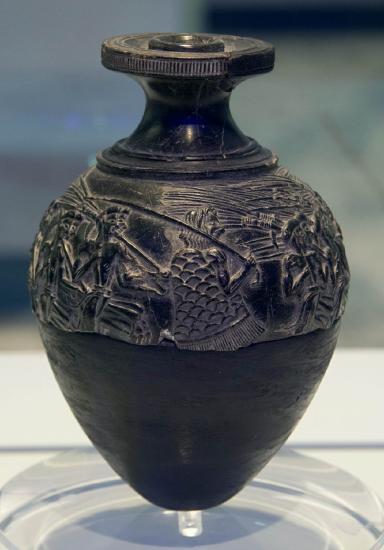
Small but powerful
Found at Hagia Triada, an elite site associated with Minoan palaces and dating to the Neopalatial period, (1600-1450 B.C.E.) the Harvester Vase displays a detailed and fascinating scene of men marching and singing in what appears to be a harvest celebration. Although it is not a grand artistic monument, this small vessel (about 4.5 inches in diameter), communicates a grace and vitality typical of Aegean Bronze Age art.
Imitating an eggshell

The Harvester Vase is actually not a vase but rather a rhyton, a ritual vessel use for pouring liquids. It has a hole at the top and would have had a hole at the bottom before it was damaged. It is made of black steatite and is shaped to look like a similar vessel made of an even more valuable material: an ostrich egg shell. Ostrich egg rhyta were some of the most luxurious and exotic ritual goods in the Aegean Bronze Age. This type of object was made by drilling holes at either end of an ostrich egg (imported from Egypt), drawing out the contents, and affixing a decorative rim on the top and at the bottom. However, what the Harvester Vase lacks in imported luxury, it makes up for in sheer sculptural power.
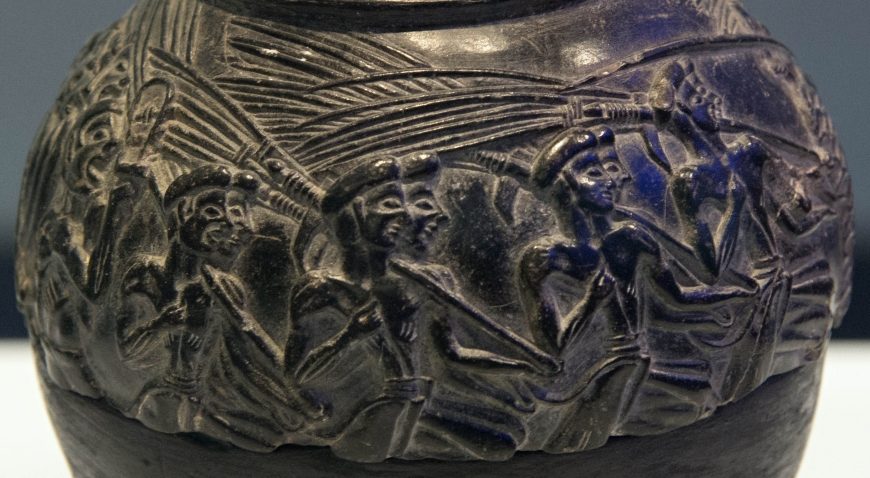
A rhythmic procession
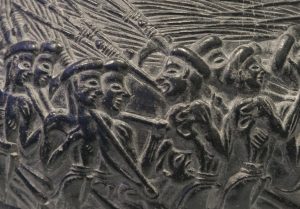
The miniature scene, carved in relief, illustrates some twenty-seven men in a procession. Most of these men are depicted in pairs, legs stepping high and right arms bent at the elbow, hands held close to the chest, and wearing identical costumes: loincloths, flat caps, carrying bags or pads on the left thigh, and on the left shoulder, a pole with a short curved blade and a three pronged fork. These men are all young, slim, and muscular, with angular faces turned up to the sky. Their paired, lock-step procession evokes marching or rhythmic movement. There is one exception to this rhythm: near the back of the group, one man turns to look behind him, perhaps because, it would appear, another has fallen just at his back.
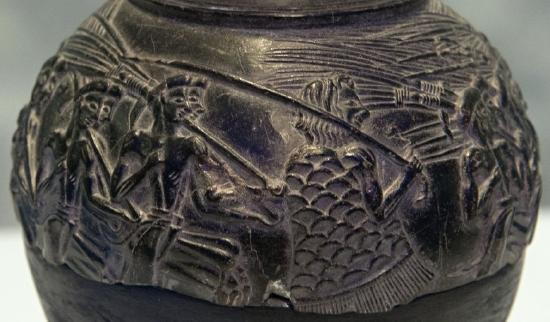
This marching group is led by an apparently older man, wearing long shaggy hair and a fringed robe with a scallop pattern (above). He carries a long staff, crooked at the bottom and tapering at the top. In the middle of the group of men behind him is another single figure, a man who looks perhaps not as young and lean as those in the group, who is shaking a sistrum (a musical instrument used in religious rituals). These were common in ancient Egypt as well as in ancient Greece and Rome; examples have been found on Bronze Age Crete as well. This man appears to be shouting or singing with his mouth wide open and he is followed close behind by a rank of four men who also have wide open mouths and wear cloaks around their shoulders.

Reaping or sowing?
As the name of this vessel indicates, it is generally thought that its decoration refers to harvesting, the key evidence being the long implement each of the younger men is carrying over his shoulder. What is not clear is exactly what the implement is. If it is a winnowing fork, these men are harvesting, collecting mature cereal crops; they will use the fork to separate the grain from its husk. If the implement is a hoe, festooned with branches, then the men are off to plant seeds—perhaps to be found in each of the men’s bags. Which it is—harvesting or planting—we may never know, but what is clear is the masculine, communal, and celebratory nature of the activity depicted on this beautiful vessel.
Octopus vase
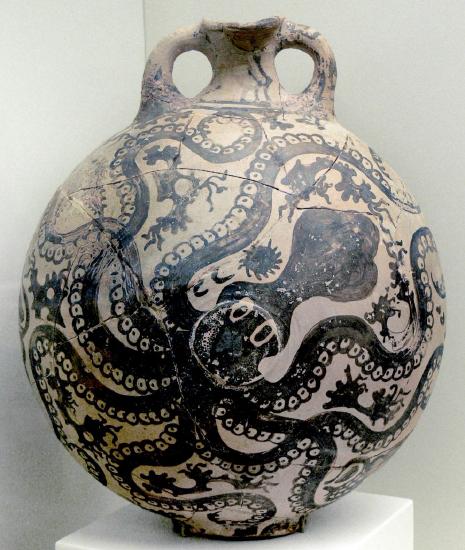
Ceramics for the wealthy
One of the most important aspects of Minoan culture was its ceramics. Pottery today may not seem particularly interesting or important, but in the second millennium B.C.E., it was a high art form and its manufacture was often closely associated with centers of power. Much like the production of porcelain for European royal houses in the 18th century, the production of pottery on Crete tells us about elite tastes, how the powerful met and shared meals, and with whom they traded.
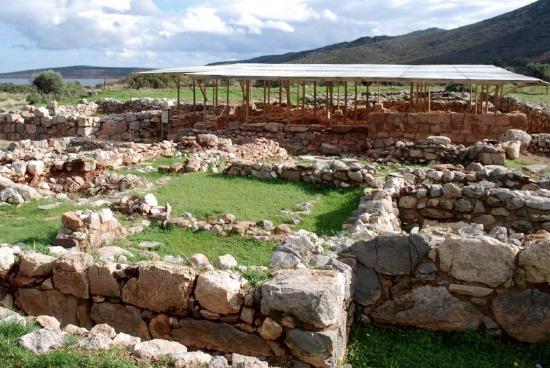
This vase, found at Palaikastro, a wealthy site on the far eastern coast of Crete, is the perfect example of elite Minoan ceramic manufacture. It is 27 cm (about 10.5 inches) high, wheel-made, hand-painted, and meant to hold a valuable liquid—perhaps oil of some kind. Its shape is somewhat unusual, constructed by slipping together, while still leather hard (clay that is not quite dry), two shallow plates which had been made on a fast spinning potter’s wheel and with highly refined clay. The circular bases of these shallow plates are still visible in the center of both sides of the flask. A spout and stirrup-style handles (which would allow the user to carefully control the flow of the liquid out of the container) were added by hand, as well as a base, to facilitate the standing upright of the vessel.
Inspired by the sea

Lastly, the Marine Style decoration would have been added. Using dark slip on the surface of the clay, the Minoan painter of this vessel filled the center with a charming octopus, swimming diagonally, with tentacles extended out to the full perimeter of the flask and wide eyes that stare out at the viewer with an almost cartoon-like friendliness. Around this creature’s limbs we find sea urchins, coral, and triton shells; no empty space is left unfilled, lending a sense of writhing energy to the overall composition.

Marine-Style pottery, of which this vessel is a prime example, is regarded as the pinnacle of Minoan palatial pottery production, specifically of the LM I period (around 1400 B.C.E.). Those who believe “hands” (that is, specific artists) can be identified in the painting of Bronze Age pottery have identified this vessel as the work of the Marine Style Master, who worked at the site of Palaikastro. The era of Marine Style pottery coincided with a period during which the Minoans’ trade networks spanned widely across the Mediterranean, from Crete to Cyprus, the Levant, mainland Greece, and Egypt. Some have connected this seafaring skill to the popularity of Marine Style pottery. The style was imitated by potters on the Greek mainland as well as the islands of Melos, and Aegina, but none could match the charm and grace of the Minoan inventors of the style.
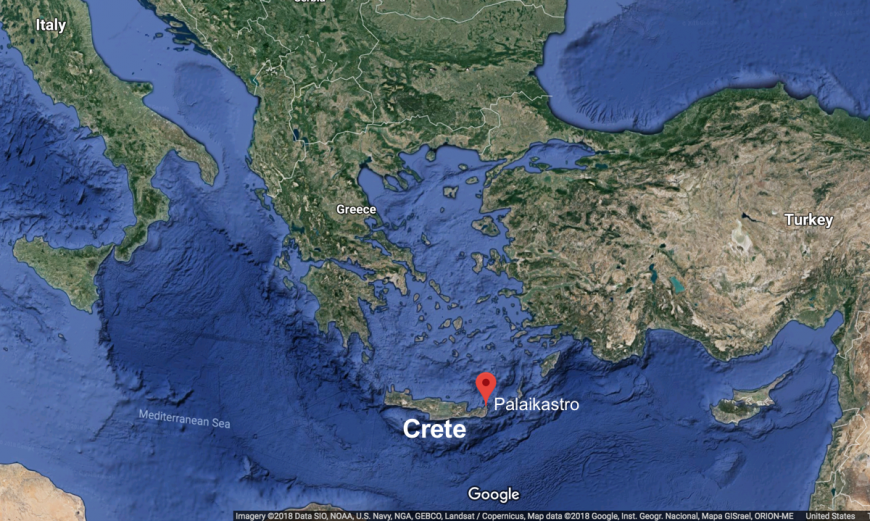
Statuette of a Male Figure (The Palaikastro Kouros)
One of the most spectacular recent finds from Crete is this statuette of a youthful male figure made of gold, ivory, serpentine, and rock crystal. It is one of only a small handful of Minoan sculptures in the round, and the largest ever found. Although it is not complete, much of it is in excellent shape and its naturalistic style is striking. It is often called the Palaikastro Kouros, as it is similar to the later Archaic Greek statues of idealized youthful elite males.
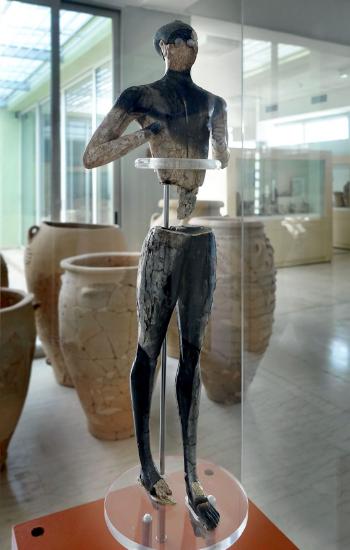
The figure was found in the excavations at the town of Palaikastro, a large archaeological site on the East coast of Crete known for, among other things, the creation of especially fine Marine Style pottery which was traded all over the island as well as throughout the Mediterranean. The statue was discovered smashed into hundreds of pieces, spread over two areas 10 meters apart, the result of the looting and burning during the town’s destruction at the end of the LM Ib period (1450 B.C.E.).
After painstaking efforts, the figurine was reconstructed to show an athletic young man standing with one foot slightly before the other, knees locked, both arms bent, hands in fists held up to the chest. The figure’s head is turned very slightly to the left, with hair cropped short except for one lock running down the middle of the scalp from front to back.
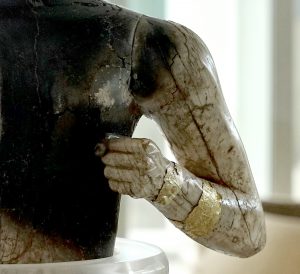
The figurine was constructed of eight separate pieces of hippopotamus ivory and was fitted together using wooden dowels. The hair was carved from a piece of serpentine stone and the eyes were inlaid with rock crystal. Sadly, the face of the figure as well as his middle section is lost; much of the surviving ivory was burned black, although still in remarkably good condition. There is evidence that the figurine was partially covered in hammered gold: specifically, the feet and part of the lower leg, the lower arms (possibly in the form of bracelets), as well as the lost middle section, likely to look like a loincloth.
Although it is hard to guess where this piece would have originally been viewed, it is clear that it was inserted into a base, which would have allowed it to stand up straight. Careful analysis has shown that the base itself was as opulent as the figurine, made from a combination of Egyptian blue and gold.
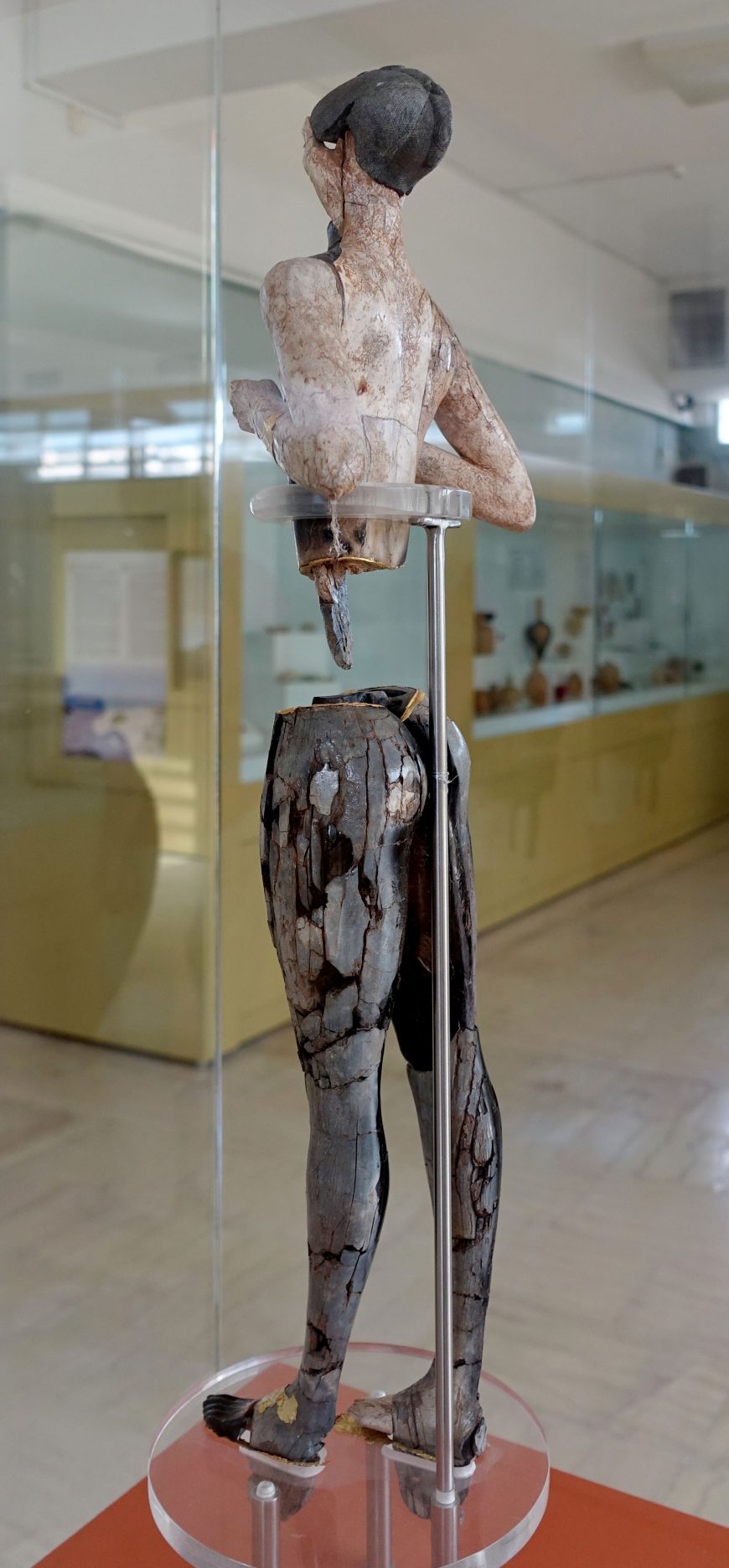
The attention to naturalistic human anatomy in the statue is extraordinary. The smooth shape and musculature of the chest, legs, and arms is highly accurate. In the feet and hands, the details of veining and even the cuticles of the fingers and toes are breathtaking to behold. However, this singular anatomical detail is not, in fact, accurate. For instance, the veins on the foot do not reflect real human vascular systems. Similarly, the thumbs of each hand are rendered too long, and curl over the knuckles of the remaining fingers too far. This uneven realism is actually a hallmark of Minoan art.
Whom does this statue represent? There is no way to know exactly. Surely it was an important figure, given the precious materials and refined skill used to create it. The archaeologists who excavated the statue at Palaikastro believe that it represents the Bronze Age forerunner of the later Classical youthful male god of the underworld, come to herald the beginning of the harvest in the fall: Diktaian Zeus.
What does this extraordinary statue tell us about the Minoans? At least two things. First of all, it tells us about a special relationship with Egypt. The two most valuable materials that make up the statue are hippopotamus ivory and gold, and both of these materials came from Egypt. Moreover, the stance of the figure (one foot in front of the other with locked knees) imitates the classic stance of Egyptian statuary. Lastly, art historians believe that the figurine employs a variant of an early Egyptian proportional canon. Therefore, much of how this figurine was conceived and produced is owed to Egypt. We might view this as evidence of a close trading relationship and likely some sort of cultural affinity as well.
The second thing the Palaikastro Kouros can tell us about the Minoans is that they were the first to create chryselephantine statuary. Chryselephantine statuary is best known from the Classical Greek era, the most famous examples being the statues of Athena and Zeus at Athens and Olympia, respectively, both created by Phidias in the 5th century B.C.E. Early examples on a much smaller scale have been found at Delphi, but this figurine from Palaikastro is the earliest known example of this important sculptural type.
Additional resources:
This work at the Archaeological Museum of Sitia
Mark Moak, “The Palaikastro Kouros,” in British School at Athens Studies, vol. 6 (2000), pp. 65-83.
Hagia Triada sarcophagus

A coffin for royalty?
Many images of Minoan rituals are fragmentary and therefore difficult to interpret. There are very few complete, narrative-style representations of religious topics, and the Hagia Triada (also sometimes spelled “Agia Triada”) is the best among them. This sarcophagus was found in 1903 by the Italian archaeologist Roberto Paribeni in Tomb 4 of the hilltop cemetery north of the site of Hagia Triada, a large and wealthy ancient Minoan settlement in south central Crete. Tomb 4 was a family tomb containing the sarcophagus, constructed of limestone, and another large ceramic coffin. The tomb was disturbed in antiquity, but some small burial goods were left behind by the looters: a carved stone bowl, a triton shell, and a fragment of a female terracotta figurine. These remaining grave goods and the elaborate nature of the Hagia Triada sarcophagus has led to the identification of Tomb 4 as that of royalty.
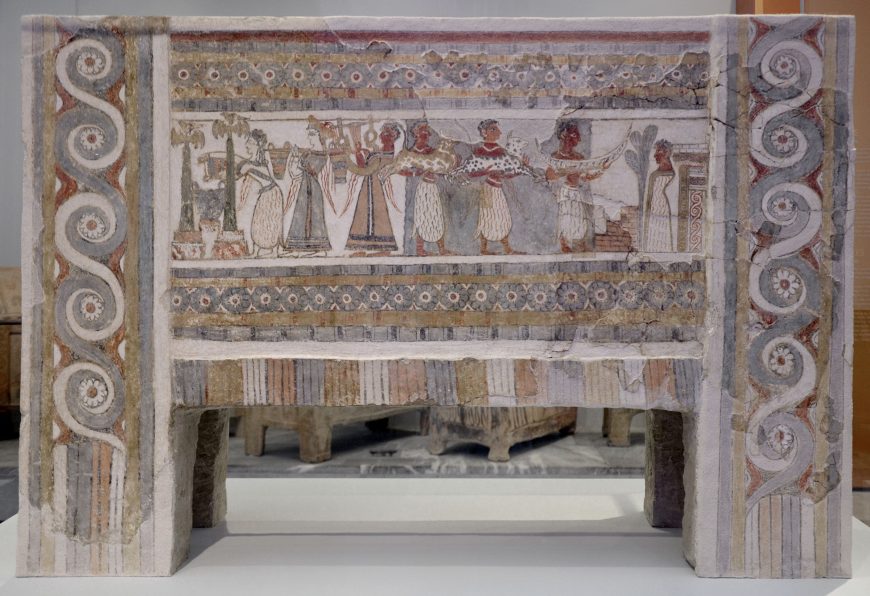
A story in fresco
The Hagia Triada sarcophagus is the only Minoan sarcophagus known to be entirely painted. It was created using fresco, like contemporaneous wall painting, and illustrates a complex narrative scene, apparently of burial and sacrifice. The object itself is substantial, measuring 1.375 meters (about 4.5 feet) long, .45 meters (about 1.5 feet) wide and .985 meters (about 3 feet) high.
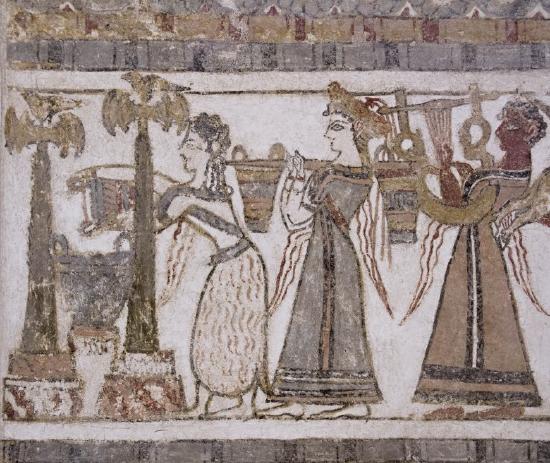
One of the long sides is the most complete and shows a funeral procession of offering bearers and a libation ceremony that features seven figures—two women and five men. From the far left, we see a female in profile facing left, dressed in an elaborate hide skirt and open short-sleeved shirt, holding a vessel in both hands while pouring the contents into a larger vessel which is resting on a stone platform between two poles. The poles are set on richly-veined stone bases and are topped with double axes surmounted by birds. Behind the woman pouring is another woman, and behind her, a man. The second woman, who is elaborately robed and wears a crown of lilies, carries on her shoulders a pole that supports two vessels identical to the one being used for pouring by the first female. The man behind her plays a lyre and is also elaborately robed.
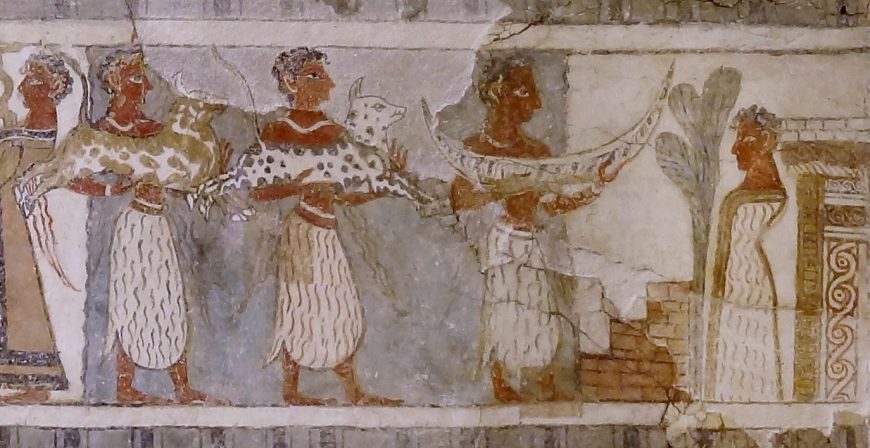
The next three people from the left are young men, each bare-chested and wearing a hide skirt. The first two hold bovine statues, one spotted brown, one black; the third man holds a model of a boat. These three men are in composite profile, with shoulders frontal but legs and head in profile, a common Egyptian painting convention. They are also set against a blue background, which is different from the rest of the scene on this side of the sarcophagus. Another man faces these three. He has no feet and looks posed like a sculpture, and it is thought this represents the deceased person. He wears a long hide robe with gold trim.
Between the three men and the deceased is a set of three steps, perhaps an altar, which has some damage at the top. There is a tree above the altar, and it is possible (based on other images of similar altars) that it is supposed to be growing out from the altar itself. Behind the deceased is another structure, elaborately painted with running spirals and inlaid with veined stone. This is thought to be the tomb of the deceased.

Offerings and altars
On the opposite side of the sarcophagus, there are another seven figures—six female and one male. Beginning again from the left, we are met with a large patch of damage which only leaves the legs and feet of two pairs of women, all with elaborate long robes, moving to the right.
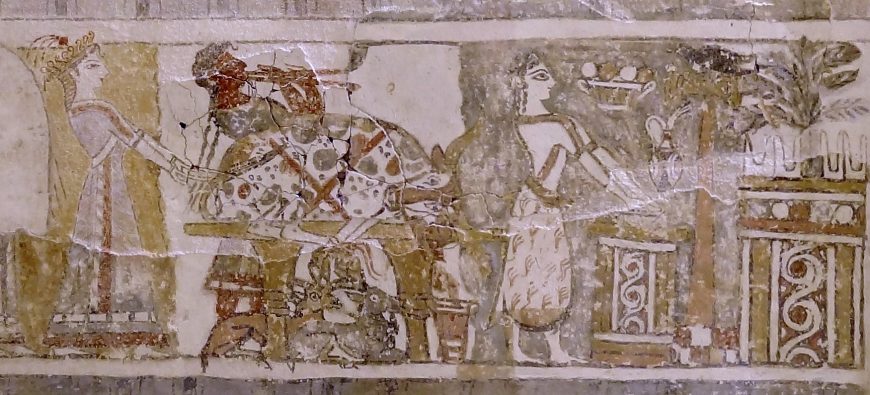
A fifth female figure, fully visible, leads them, also well-dressed and wearing a lily crown. She is in full profile, with yellow hair, her arms stretched down towards to the ground. She and the four women behind her are all set in a bright yellow background. Moving to the left, the background color changes to white and against this is a male double-flute player wearing a short blue robe and long curls. He stands behind an offering table on which lies a trussed bull on its side, facing the viewer. Red streaks of blood can be seen coming from the bull’s neck and pouring into a vessel that sits at the foot of the table. Beneath the table are two small goats, possibly awaiting a similar fate.
To the right of this large altar the background color changes to blue; a woman stands before another low altar wearing a hide skirt. This altar is decorated with a red and white running spiral design and on top sits a shallow grey bowl, possibly silver, above which floats in the field a painted beaked pitcher and a two-handled bowl with what appears to be round fruit—possibly all offerings. To the right of this altar is another pole, this one set in a red and white checked base, with a double axe and bird at the top. Lastly, in the field is an architectural structure, also with red and white running spirals and four pairs of horns on top and from which grows a great green tree.
No surface left undecorated
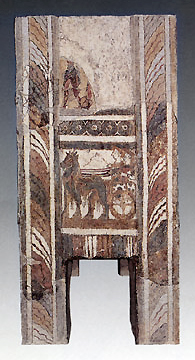
One of the short sides of the Hagia Triada sarcophagus has two scenes situated one on top of the other, while the opposite short side has only one scene. On the side with two scenes, the top one is almost entirely lost from damage but enough remains to indicate a procession of men in short pointed kilts of richly woven textiles. Beneath this scene is a horse-drawn chariot with an ox-hide carriage in which two women ride, both dressed in elaborate robes and one holding a whip.

On the other short side there is a griffin–drawn chariot with another pair of women riding in an ox-hide carriage also richly dressed and wearing pointed hats. The griffins are multicolored and spread their wings, as if in flight; above them flies a bird in profile, moving in the opposite direction.
Surrounding all five of these scenes on the Hagia Triada sarcophagus are framing elements: rows of rosettes, bands of colors to imitate richly veined stone, running spirals with central rosettes, and colorful striped bands. It is colorfully painted from top to bottom.
Simple story, complex questions
In some ways what we see on the Hagia Triada sarcophagus is simple to understand: women and men in elite dress are busy making sacrifices and preparing the deceased for burial before his tomb. However, looking more deeply, many questions remain. How is it to be read? Is there a prescribed order to the images? What does the change in background color mean? Who exactly are these people—are they all priestesses and priests? Are they mythological characters? Who was the deceased? Was this a special sort of burial, or did everybody get this treatment? These are questions that have yet to be answered with confidence.
Additional resources:
Bull-leaping fresco from the palace of Knossos

Taking the bull by the horns
Bull sports—including leaping over them, fighting them, running from them, or riding them—have been practiced all around the globe for millennia. Perhaps the best-loved ancient illustration of this, called the bull-leaping or Toreador fresco, comes from the site of Knossos on the island of Crete. The wall painting, as it is now reconstructed, shows three people leaping over a bull: one person at its front, another over its back, and a third at its rear.
The image is a composite of at least seven panels, each .78 meters (about 2.5 feet) high. Fragments of this extensive wall painting were found very badly damaged in the fill above the walls in the Court of the Stone Spout, on the east side of the Central Court at Knossos. The fact that the paintings were found in fill indicates that this wall painting was destroyed as part of a renovation. The pottery which was found together with the fragments gives us its date, likely LM II (around 1400 B.C.E.).
Reconstructed but still incomplete

When Sir Arthur Evans, the first archaeologist to work at Knossos, found the fragments, he recognized them as illustrating an early example of bull sports, and he was eager to create a complete image that he could share with the world. He hired a well-known archaeological restorer, Émile Gilliéron, to create the image we know today from the largest bits of the seven panels. Unfortunately, it is impossible to reconstruct all of the original panels and to get a sense of the painting at all, we are left with Gilliéron’s reconstruction.
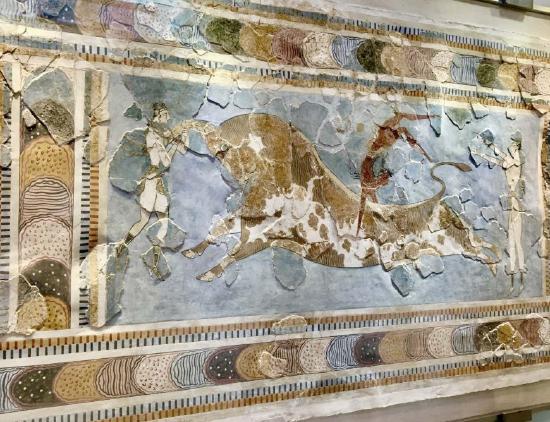
Visual gymnastics
What we see is a freeze-frame of a very fast moving scene. The central image of the fresco as reconstructed is a bull charging with such force that its front and back legs are in midair. In front of the bull is a person grasping its horns, seemingly about to vault over it. The next person is in mid-vault, upside down, over the back of the bull, and the final person is facing the rear of the animal, arms out, apparently just having dismounted—“sticking the landing,” as they say in gymnastics.
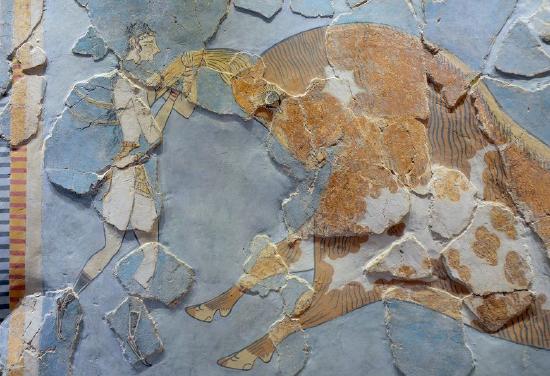
The people on either side of the bull, as reconstructed, bear markers of both male and female gender: they are painted white, which indicates a female figure according to ancient Egyptian gender-color conventions, which we know the Minoans also used. But both characters wear merely a loincloth, which is male dress. The hairstyle (curls at the top with locks falling down the back) is not uncommon in representations of both youthful males and females. Many interpretations of this gender crossing are possible, but there is little evidence to support one over another, unfortunately. At the very least, we can say that the representation of gender in the Late Aegean Bronze Age was fluid.
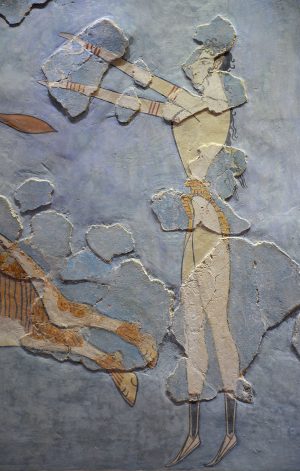
The person at the center of the action, vaulting over the bull’s back, is painted brown, which indicates male gender according to ancient Egyptian gender-color conventions, and this makes sense considering his loincloth. It is interesting to note that the muscles of all three of the bull leapers, at their thighs and chests, have been very delicately articulated, accentuating their athletic build.
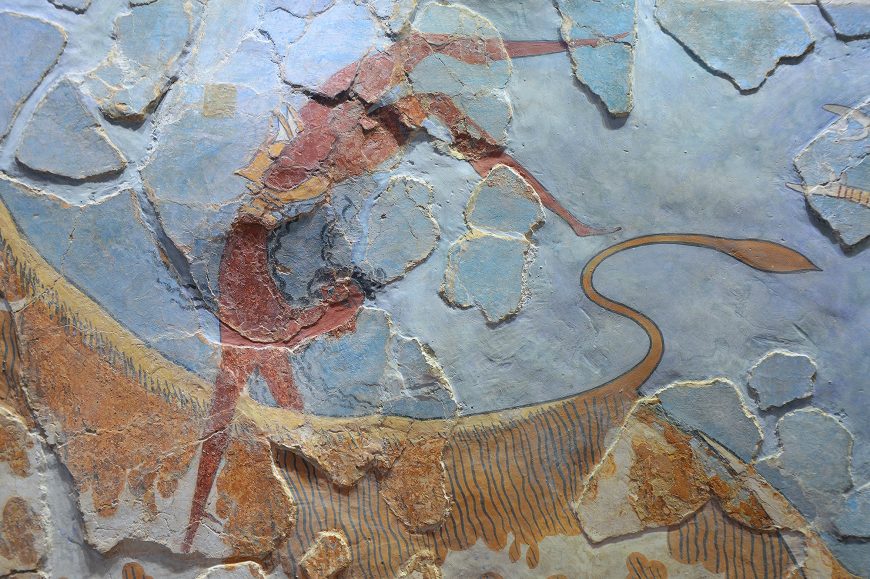
The background of the scene is blue, white, or yellow monochrome, and indicate no architectural context for the activity. Moreover, the seven panels and Gilliéron’s composite reconstruction all show a border of painted richly variegated stones overlapping in patches. So, it seems we are meant to see these scenes as abstracted action within frames, not part of a wider visual field or narrative.
A rite of passage?
The most interesting question about the bull leaping paintings from Knossos is what they might mean. We cannot understand the whole bull-leaping cycle in detail as it is so fragmentary, but we know that it covered a lot of wall space and a considerable amount of resources must have been expended to create it.
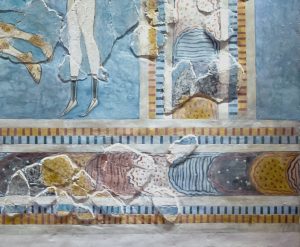
As mentioned above, many cultures across space and time have engaged in bull sports, and they all have a few things in common. First, these sports are life-threatening. To race, dance with, leap over, or kill a bull might very well get you killed. Second, these activities are usually performed before a crowd: they are a civic event, publicly presented and recorded in memory. Third, those who participate in these bull activities are often youths at an age when they are passing from childhood into adulthood and the achievement of the bull sport contributes to that passage. Anthropologists refer this sort of activity as a “rite of passage,” which, when witnessed by one’s community, establishes the participant as an adult.
Therefore, we might surmise that the bull leaping scenes from Knossos refer to such a rite of passage ceremony. Many have identified the Central Court (Theatral area) just beyond the west façade of the palace at Knossos as locations where bull-leaping ceremonies might have taken place. We may never know the exact meaning of these paintings, but they continue to resonate with us today—not only because of their beauty and dynamism, but because they represent an activity that is still an important part of many cultures around the world.
Minoan woman or goddess from the palace of Knossos (“La Parisienne”)

“Parisian” from ancient Crete
This image of a young woman with a bright dress and curly hair is among the best known images in Minoan art. It is also one of the few representations of Minoan people rendered in color and detail, and it is a beautiful example of Minoan wall painting. Shortly after it was first discovered by Sir Arthur Evans at Knossos, it was seen by Edmond Pottier, a famous art historian of Greek pottery, who likened her charming look to the contemporary women of Paris. She has been known as “La Parisienne” ever since.
The sacred knot
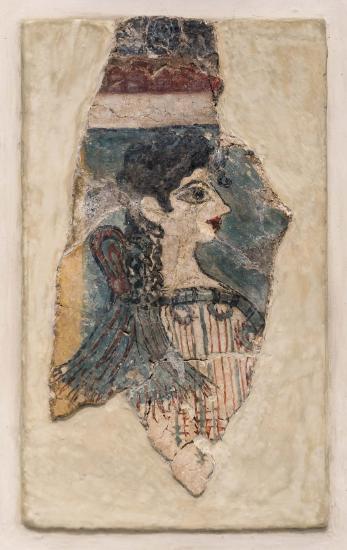
Only La Parisienne’s head and upper body are preserved. Her hair is black and curly, with one curl springing down onto her forehead and others cascading down her neck and upper back. Her skin is white, which is in imitation of the ancient Egyptian color convention (women painted white, men brown), and her large, darkly outlined eye also reminds us of Egyptian style, but her bright red lips are unique. She wears an elaborately woven blue and red striped dress, with a blue banded edge attached with red flecked loops. Tied to the back of the dress is a “sacred knot,” as Evans first called it. This is a loop of long cloth tied with another loop at the nape of the neck, leaving a length of the cloth trailing down the back.
This is one of only two representations of a woman actually wearing a sacred knot, although the knots themselves are found on seals, painted on pottery, in other frescos, and rendered in ivory or faience. This knot is thought to designate the wearer as a holy person, so this Minoan woman may be a priestess.
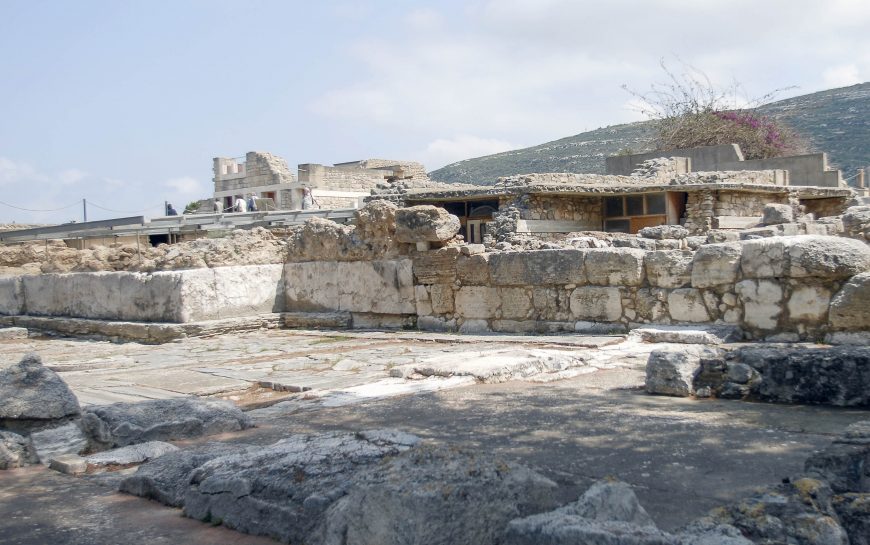
Found in fragments
The wall painting of which La Parisienne is a part was discovered heavily damaged and fallen from an upper story in the western wing of Knossos. It was painted in buon fresco (on wet plaster) as most Minoan wall paintings were, and given its archaeological context is likely one of the last painted works of the palace, dating to LM III (around 1350 B.C.E.). Specifically, this fragment was part of a two tiered scene that is about a half-meter (about 1.5 feet) wide, called the Camp Stool fresco (shown below as a reconstruction). Featured on both the top and bottom panels are pairs of men and women in profile sitting and standing and holding up elegant vessels. La Parisienne comes from one of the female pairs.

It has been suggested that the part of the palace of Knossos from which this painted scene fell was used for ceremonies and feasting; if this is true, subject matter depicting toasts being made would fit in nicely. Whatever her original meaning, La Parisienne is an enduring testament to the skill of Minoan fresco painters.
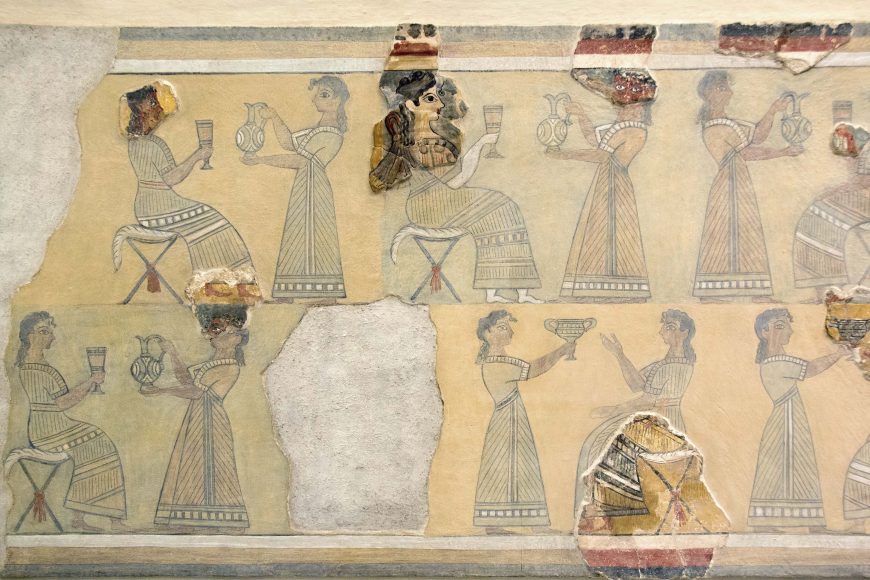
Mycenaean art
Mycenaean culture flourished on the Greek mainland in the Late Bronze Age. The name comes from the site of Mycenae, where the culture was first recognized after the 1876 excavations by Heinrich Schliemann.
c. 1600 - 1100 B.C.E.
The “Palace” and Grave Circle A
by DR. STEVEN ZUCKER and DR. BETH HARRIS
Seeking the mythic cities of Homer, Heinrich Schliemann identified Mycenae in the 19th century.
Smarthistory images for teaching and learning:


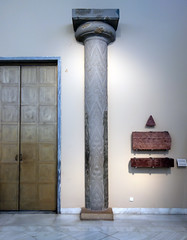
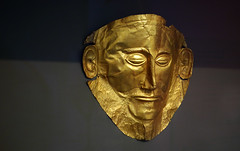
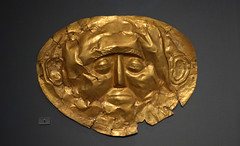
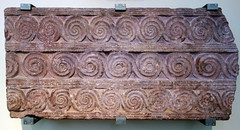
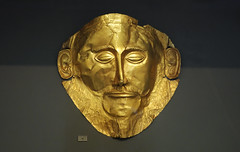
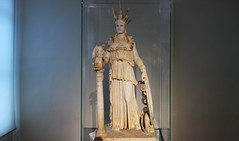

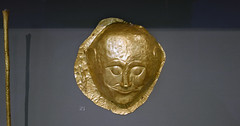
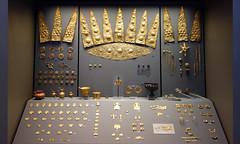
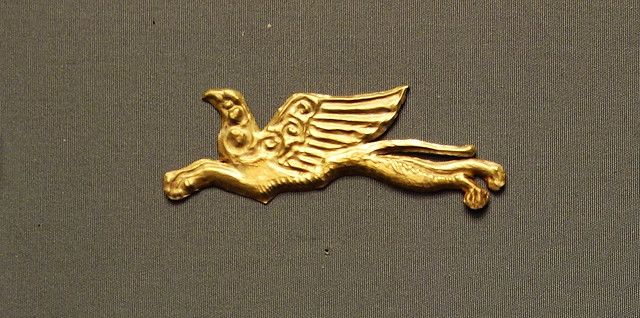

Mask of Agamemnon
by DR. STEVEN ZUCKER and DR. BETH HARRIS
“I have gazed into the face of Agamemnon,” boasted the man who discovered it—but is it really the Homeric hero?
Smarthistory images for teaching and learning:


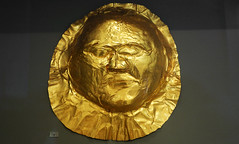
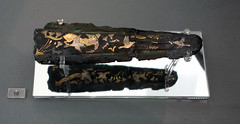

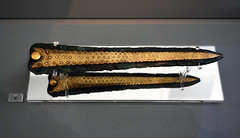

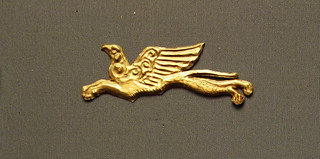

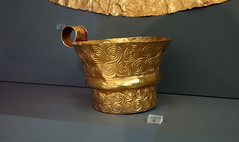
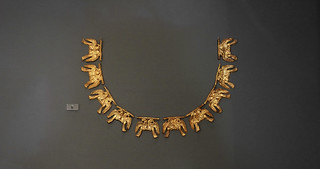

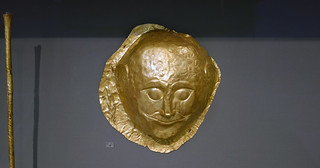
The Treasury of Atreus
by DR. STEVEN ZUCKER and DR. BETH HARRIS
Below the great citadel of Mycenae, a passage into a hillside leads to a massive beehive-shaped tomb.
Smarthistory images for teaching and learning:
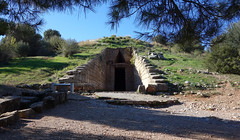




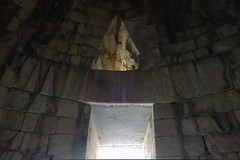
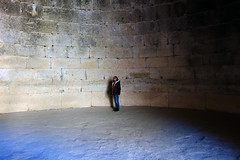

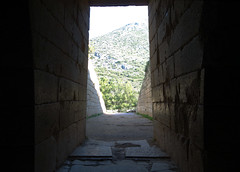
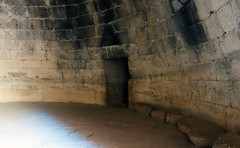
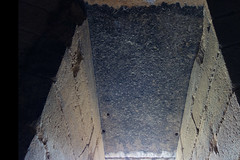

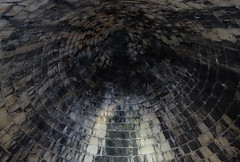

Lion Gate
by DR. STEVEN ZUCKER and DR. BETH HARRIS
Approaching Mycenae was awe inspiring: a massive hill, walls of enormous stones, and the fearsome Lion Gate.
Smarthistory images for teaching and learning:

